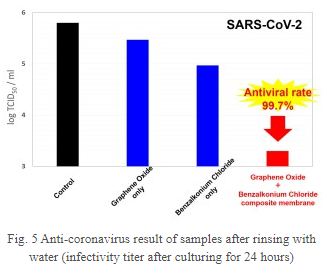Antiviral graphene oxide.
posted on
Oct 20, 2021 08:36AM

Hydrothermal Graphite Deposit Ammenable for Commercial Graphene Applications

DEVELOPMENT OF AN ANTIBACTERIAL AND ANTIVIRAL GRAPHENE OXIDE COMPOSITE MEMBRANE WITH HIGH WATER RESISTANCE - INACTIVATING VARIOUS BACTERIA AND VIRUSES INCLUDING SARS-COV-2, TO IMPROVE WET AREA SANITAT |
| Posted By Terrance Barkan, Thursday, October 14, 2021 |
 NIPPON SHOKUBAI CO., LTD. (Headquarters: Osaka, Japan, President: Yujiro Goto, hereinafter "Nippon Shokubai") and a group led by Dr. Hirofumi Miyaji from the Department of Endodontics and Periodontics, Hokkaido University Hospital, have developed a graphene oxide composite membrane with inactivation effects on various bacteria and viruses including SARS-CoV-2, which causes COVID-19. The graphene oxide composite membrane comprising graphene oxide and an antibacterial/antiviral agent can function as an antibacterial/antiviral membrane even in a wet environment. NIPPON SHOKUBAI CO., LTD. (Headquarters: Osaka, Japan, President: Yujiro Goto, hereinafter "Nippon Shokubai") and a group led by Dr. Hirofumi Miyaji from the Department of Endodontics and Periodontics, Hokkaido University Hospital, have developed a graphene oxide composite membrane with inactivation effects on various bacteria and viruses including SARS-CoV-2, which causes COVID-19. The graphene oxide composite membrane comprising graphene oxide and an antibacterial/antiviral agent can function as an antibacterial/antiviral membrane even in a wet environment.[Characteristics of the graphene oxide composite membrane] • Useful in environments requiring both water resistance and antibacterial/antiviral properties • Selectable for various antibacterial/antiviral agents • Colorless and transparent, without losing the color tone of the base material  Graphene oxide is a type of nanocarbon material and has a high aspect ratio sheet structure with 1 nm thickness and several micrometers width (Fig. 1). The effectiveness of graphene oxide has been confirmed in various uses, and it is expected to be put into application in a wide range of fields. However, mass production on an industrial scale has been difficult. Using our techniques to safely and stably control chemical reactions in chemical production that we have accumulated to this day, Nippon Shokubai has solved various issues in graphene oxide mass production, and established mass production technology. Graphene oxide has a high adhesiveness to various base materials, and also strongly interacts with various molecules, polymers, etc. by utilizing its shape and rich oxygen-functional groups. Utilizing these properties of Graphene oxide, it can improve the interaction between the base material and substances which have low adhesive properties. Therefore it can lead to water resistance and long-term stability (Fig. 2).  In the field of antibacterial/antiviral agents and applications, it has been necessary to develop a technology that exhibits antibacterial/antiviral effects with long-term stability and high water resistance by a simple method. However, general disinfection methods and antimicrobial/antiviral methods have a low water resistance, making it difficult to maintain antimicrobial/antiviral effects in a wet environment. Nippon Shokubai and Dr. Miyaji’s group developed the composite membrane combining graphene oxide and antibacterial/antiviral agents such as benzalkonium chloride. We confirmed that the composite membrane has a strong intercalation between the antibacterial/antiviral agents and the base material across the graphene oxide. From this effect, the antibacterial/antiviral agents on graphene oxide were reinforced even in a wet environment therefore, the composite membrane works as an antibacterial/antiviral membrane with resistance to water washing and wetting (Fig.3).  Furthermore, the graphene oxide membrane is a colorless and transparent monolayer membrane, and does not reduce the color tones of various base materials (Fig. 4). To further verify its antibacterial/antiviral properties, Nippon Shokubai and Dr. Miyaji’s group conducted an antiviral property evaluation using the novel coronavirus (SARS-CoV-2 which causes COVID-19). [Experimental method] The antibacterial/antiviral capacity of the following four samples after washing with water was analyzed for antibacterial/antiviral capacity. • Substrate only (control, with washing) • Only graphene oxide on substrate (with washing) • Only benzalkonium chloride on substrate (with washing) • Graphene oxide-benzalkonium chloride composite membrane on substrate (with washing)  [Results] Only the graphene oxide-benzalkonium chloride composite membrane shows a strong antiviral effect, and the effect with graphene oxide only or benzalkonium chloride only was weaker (Fig. 5). It shows that the water resistance is improved by compositing graphene oxide and antibacterial/antiviral agents. We also confirmed that the graphene oxide composite membrane remains even in the sample that was stored in water for 1 month. The graphene oxide composite membrane can be applied to a wide range of bacteria and virus species, because graphene oxide can be  combined with various antibacterial/antiviral agents selected to suit the target bacteria or virus. We also confirmed the effect against various bacteria and viruses other than the novel coronavirus. combined with various antibacterial/antiviral agents selected to suit the target bacteria or virus. We also confirmed the effect against various bacteria and viruses other than the novel coronavirus.Utilizing this colorless and transparent graphene oxide composite membrane, it is expected that the antibacterial/antiviral effects can be maintained for a long period without losing the color tone of base materials, even with environments or materials for which both water resistance and antibacterial/antiviral properties are required. Graphene oxide composite membranes can be applied to wet area environments such as sinks and bathrooms, and window glass and sashes which tend to have condensation.
Tags: COVID-19 Graphene Graphene Oxide Hirofumi Miyaji Hokkaido University Hospital Nippon Shokubai Yujiro Goto |